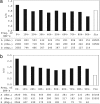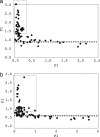Adaptive evolution in humans revealed by the negative correlation between the polymorphism and fixation phases of evolution
- PMID: 17360451
- PMCID: PMC1820682
- DOI: 10.1073/pnas.0605565104
Adaptive evolution in humans revealed by the negative correlation between the polymorphism and fixation phases of evolution
Abstract
The selective forces acting on amino acid substitutions may be different in the two phases of molecular evolution: polymorphism and fixation. Negative selection and genetic drift may dominate the first phase, whereas positive selection may become much more significant in the second phase. However, the conventional dichotomy of synonymous vs. nonsynonymous changes does not offer the resolution needed to study the dynamics of these two phases. Following previously published methods, we separated amino acid changes into 75 elementary types (1-bp substitution between their respective codons). The likelihood of each type of amino acid change becoming polymorphic (PI, which stands for "polymorphic index"), relative to synonymous changes, can then be calculated. Similarly, the likelihood of fixation (FI, for "fixation index"), conditional on common polymorphisms, is also calculated. Using Perlegen and HapMap data on human polymorphisms and the chimpanzee sequences as the outgroup, we compared the evolutionary dynamics of the 75 elementary changes in the two phases. We found a strong "L-shaped" negative correlation (P < 0.001) between FI and PI. Only those changes with low PIs show FI > 1, which is often a signature of adaptive evolution. These patterns suggest that negative and positive selection operate more effectively on the same set of amino acid changes and that approximately 10-13% of amino acid substitutions between humans and chimpanzee may be adaptive.
Conflict of interest statement
The authors declare no conflict of interest.
Figures



Similar articles
-
Selection in favor of nucleotides G and C diversifies evolution rates and levels of polymorphism at mammalian synonymous sites.J Theor Biol. 2006 Jun 21;240(4):616-26. doi: 10.1016/j.jtbi.2005.10.020. Epub 2005 Dec 15. J Theor Biol. 2006. PMID: 16343547
-
Evidence for positive selection at the pantophysin (Pan I) locus in walleye pollock, Theragra chalcogramma.Mol Biol Evol. 2004 Jul;21(7):1391-400. doi: 10.1093/molbev/msh141. Epub 2004 Apr 14. Mol Biol Evol. 2004. PMID: 15084678
-
Features of recent codon evolution: a comparative polymorphism-fixation study.J Biomed Biotechnol. 2010;2010:202918. doi: 10.1155/2010/202918. Epub 2010 Jun 7. J Biomed Biotechnol. 2010. PMID: 20622912 Free PMC article.
-
Evolution: natural selection in the evolution of humans and chimps.Curr Biol. 2005 Nov 22;15(22):R919-22. doi: 10.1016/j.cub.2005.10.060. Curr Biol. 2005. PMID: 16303548 Review.
-
Nonadaptive processes in primate and human evolution.Am J Phys Anthropol. 2010;143 Suppl 51:13-45. doi: 10.1002/ajpa.21439. Am J Phys Anthropol. 2010. PMID: 21086525 Review.
Cited by
-
Uncovering adaptive evolution in the human lineage.BMC Genomics. 2014 Jul 16;15(1):599. doi: 10.1186/1471-2164-15-599. BMC Genomics. 2014. PMID: 25030307 Free PMC article.
-
Inferring selection on amino acid preference in protein domains.Mol Biol Evol. 2009 Mar;26(3):527-36. doi: 10.1093/molbev/msn286. Epub 2008 Dec 18. Mol Biol Evol. 2009. PMID: 19095755 Free PMC article.
-
Pervasive positive selection on duplicated and nonduplicated vertebrate protein coding genes.Genome Res. 2008 Sep;18(9):1393-402. doi: 10.1101/gr.076992.108. Epub 2008 Jun 18. Genome Res. 2008. PMID: 18562677 Free PMC article.
-
Integrative analysis of young genes, positively selected genes and lncRNAs in the development of Drosophila melanogaster.BMC Evol Biol. 2014 Dec 4;14:241. doi: 10.1186/s12862-014-0241-9. BMC Evol Biol. 2014. PMID: 25470998 Free PMC article.
-
Estimating the rate of irreversibility in protein evolution.Genome Biol Evol. 2012;4(12):1213-22. doi: 10.1093/gbe/evs096. Genome Biol Evol. 2012. PMID: 23132897 Free PMC article.
References
Publication types
MeSH terms
Substances
Grants and funding
LinkOut - more resources
Full Text Sources
Research Materials
Miscellaneous

